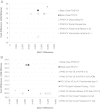Cost-effectiveness and cost utility analysis of three pneumococcal conjugate vaccines in children of Peru
- PMID: 24171921
- PMCID: PMC4228443
- DOI: 10.1186/1471-2458-13-1025
Cost-effectiveness and cost utility analysis of three pneumococcal conjugate vaccines in children of Peru
Abstract
Background: The clinical and economic burden associated with invasive and non-invasive pneumococcal and non-typeable Haemophilus influenzae (NTHi) diseases is substantial in the Latin America and Caribbean region, where pneumococcal vaccines have only been introduced to a few countries. This study analyzed the cost-effectiveness and cost utility of three different pneumococcal conjugate vaccines (PCVs) for Peru.
Methods: A Markov model that simulated the disease processes in a birth cohort over a lifetime, within 1,128 month cycles was used to evaluate the cost-effectiveness of 10-valent pneumococcal NTHi protein D conjugate vaccine (PHiD-CV) and 7- and 13-valent PCVs (PCV-7 and PCV-13). Expected quality-adjusted life years (QALYs), cost-savings and incremental cost-effectiveness ratios (ICERs) were calculated.
Results: Without vaccination, pneumonia was associated with the greatest health economic burden (90% of QALYs lost and 63% of lifetime direct medical costs); while acute otitis media (AOM) was responsible for 1% of QALYs lost and 25% of direct medical costs. All vaccines were predicted to be cost-effective for Peru, with PHiD-CV being most cost-effective. PHiD-CV was predicted to generate 50 more QALYs gained and required a reduced investment (-US$ 3.4 million) versus PCV-13 (discounted data), and was therefore dominant and cost saving. The probabilistic sensitivity analysis showed that PHiD-CV generated more QALYs gained at a reduced cost than PCV-13 in 84% of the simulations and less QALYs gains at a reduced cost in 16%. Additional scenarios using different assumptions on vaccine efficacies based on previous evidence were explored, but no significant change in the overall cost-effective results were observed.
Conclusions: The results of this modeling study predict that PCVs are likely to be a cost-effective strategy to help relieve the epidemiological and economic burden associated with pediatric pneumococcal and NTHi diseases for Peru. PHiD-CV is likely to be a dominant (better health gains at a reduced net cost) intervention compared to PCV-13 or PCV-7. The most significant drivers for these results are the better health and economic profile of PHiD-CV against AOM and its reduced cost per dose available through the PAHO Revolving Fund in the LAC region.
Figures



Similar articles
-
Cost-effectiveness analysis of infant pneumococcal vaccination with PHiD-CV in Korea.Hum Vaccin Immunother. 2018 Jan 2;14(1):85-94. doi: 10.1080/21645515.2017.1362513. Epub 2017 Nov 8. Hum Vaccin Immunother. 2018. PMID: 29115905 Free PMC article.
-
Cost-effectiveness analysis of routine pneumococcal vaccination in the UK: a comparison of the PHiD-CV vaccine and the PCV-13 vaccine using a Markov model.BMJ Open. 2016 Nov 30;6(11):e010776. doi: 10.1136/bmjopen-2015-010776. BMJ Open. 2016. PMID: 27903558 Free PMC article.
-
Overall effectiveness of pneumococcal conjugate vaccines: An economic analysis of PHiD-CV and PCV-13 in the immunization of infants in Italy.Hum Vaccin Immunother. 2017 Oct 3;13(10):2307-2315. doi: 10.1080/21645515.2017.1343773. Epub 2017 Jul 12. Hum Vaccin Immunother. 2017. PMID: 28700264 Free PMC article.
-
Pneumococcal conjugate vaccines for preventing acute otitis media in children.Cochrane Database Syst Rev. 2019 May 28;5(5):CD001480. doi: 10.1002/14651858.CD001480.pub5. Cochrane Database Syst Rev. 2019. Update in: Cochrane Database Syst Rev. 2020 Nov 24;11:CD001480. doi: 10.1002/14651858.CD001480.pub6. PMID: 31135969 Free PMC article. Updated.
-
Ten years of experience with the pneumococcal non-typeable Haemophilus influenzae protein D-conjugate vaccine (Synflorix) in children.Expert Rev Vaccines. 2020 Mar;19(3):247-265. doi: 10.1080/14760584.2020.1738226. Epub 2020 Mar 20. Expert Rev Vaccines. 2020. PMID: 32195602 Review.
Cited by
-
Impact of vaccine herd-protection effects in cost-effectiveness analyses of childhood vaccinations. A quantitative comparative analysis.PLoS One. 2017 Mar 1;12(3):e0172414. doi: 10.1371/journal.pone.0172414. eCollection 2017. PLoS One. 2017. PMID: 28249046 Free PMC article.
-
Inclusion of Additional Unintended Consequences in Economic Evaluation: A Systematic Review of Immunization and Tuberculosis Cost-Effectiveness Analyses.Pharmacoecon Open. 2021 Dec;5(4):587-603. doi: 10.1007/s41669-021-00269-4. Epub 2021 May 4. Pharmacoecon Open. 2021. PMID: 33948928 Free PMC article.
-
A cost-effectiveness analysis of PHiD-CV compared to PCV13 in a national immunization program setting in Tunisia.Hum Vaccin Immunother. 2022 Nov 30;18(5):2079305. doi: 10.1080/21645515.2022.2079305. Epub 2022 Jun 15. Hum Vaccin Immunother. 2022. PMID: 35703731 Free PMC article.
-
Economic and cost-effectiveness aspects of vaccines in combating antibiotic resistance.Hum Vaccin Immunother. 2023 Dec 31;19(1):2215149. doi: 10.1080/21645515.2023.2215149. Hum Vaccin Immunother. 2023. PMID: 37248971 Free PMC article. Review.
-
Distribution of serotypes, vaccine coverage, and antimicrobial susceptibility pattern of Streptococcus pneumoniae in children living in SAARC countries: a systematic review.PLoS One. 2014 Sep 30;9(9):e108617. doi: 10.1371/journal.pone.0108617. eCollection 2014. PLoS One. 2014. PMID: 25268974 Free PMC article.
References
-
- O’Brien KL, Wolfson LJ, Watt JP, Henkle E, Deloria-Knoll M, McCall N, Lee E, Mulholland K, Levine OS, Cherian T. Hib and Pneumococcal Global Burden of Disease Study Team. Burden of disease caused by Streptococcus pneumoniae in children younger than 5 years: global estimates. Lancet. 2009;374(9693):893–902. doi: 10.1016/S0140-6736(09)61204-6. - DOI - PubMed
-
- Valenzuela MT, O’Loughlin R, De La Hoz F, Gomez E, Constenla D, Sinha A, Valencia JE, Flannery B, De Quadros CA. The burden of pneumococcal disease among Latin American and Caribbean children: review of the evidence. Rev Panam Salud Publica. 2009;25(3):270–279. - PubMed
-
- Ministerio de Salud: Resolución Ministerial No 457–2009. [ftp://ftp2.minsa.gob.pe/normaslegales/2009/RM457-2009.pdf]
-
- Ministerio de Salud. Convenio de cooperación técnica entre la Organización Panamericana de la Salud (OPS) y el Ministerio de Salud de la República del Peru (MINSA) para la adquisición de vacunas, jeringas y otros insumos relacionados. [ftp://ftp2.minsa.gob.pe/descargas/Transparencia/01InformacionInst/archiv...
-
- World Health Organization. WHO Vaccine Preventable Diseases Monitoring System. 2011 Global summary. [ http://apps.who.int/immunization_monitoring/globalsummary/countries?coun...]
Publication types
MeSH terms
Substances
LinkOut - more resources
Full Text Sources
Other Literature Sources
Medical

